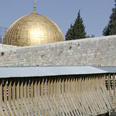
Friendship on Temple Mount
The wonderful story of Jewish-Muslim cooperation under Turkish rule
And already Arab Knesset member Talab a-Sana is begging to know what on earth do the Turks have to do with the Temple Mount, and wouldn't it be easier for the Israeli government to coordinate the works with the local Waqf than with far off Turkey? It's as if a-Sana wanted to say: A close neighbor is better than a distant brother. But that same distant brother once ruled the nation, and throughout the 400 years of its rule here, Jerusalem's Ottoman governor was responsible for the third most sacred site to Islam after Mecca and Medina – the al-Aqsa Mosque and the Dome of the Rock.
In the years 1992-3 the late King Hussein of Jordan financed the renovations of the golden dome, which was carried out by a construction company from Northern Ireland. On a visit to the site during those renovations I discovered a story that wasn’t known until then, regarding the Jewish-Ottoman-Palestinian connection to the mosques on Temple Mount.
Story of the iron panel
The Dome of the Rock was surrounded with scaffolding, and before ascending one of them a friend of mine drew my attention to an iron panel that lay on the floor and was inscribed in French. The foreman of the Irish construction company said the panel had been found between the two halves of the crescents at on top of the mosque, and was temporarily dismantled so that the dome could be coated in gold.
The words in French revealed that the Mosque had been renovated in 1899 during Turkish rule, and that the works had been assisted by the Jewish community in Jerusalem led by a public figure called Avraham (Albert) Entebbe, who among his numerous other activities was also the principal of the city's "Kol Israel Haverim" school.
Entebbe, who was the undersigned on the French inscription, was known for his courageous ties with the heads of the Ottoman rule, and the inscription noted that for the purpose of renovating the mosques on the Temple Mount five acclaimed Jewish artists had been invited to Jerusalem. The Jewish stone carvers, wood carvers and iron mongers from various cities in the Mediterranean basin, shared their skills with their Muslim brothers during months of work.
Zenith of Jewish-Muslim cooperation
The inscription also noted that all the students at Entebbe's school were given a three-month leave in order to assist their Muslim brothers in the renovations works on Temple Mount. In the last lines of the inscription, Entebbe described the ideal cooperation and understanding that prevailed between Jews and Muslims in the Holy City, which reached its zenith when the Jews undertook renovations of the Temple Mount mosques in 1899.
I told the Irish foreman about my discovery, and asked him to look after the iron panel so that I could take a photograph of it. The foreman apparently told Waqf representatives about the panel, and when we came back to the site the next day the panel was no longer there. The foreman said the Waqf had taken it away. When I asked one of them a few days later where the iron panel was, he said that he didn’t know what I was talking about.
The iron panel, which told the story of the wonderful cooperation between the Jews and Muslims under Turkish rule, disappeared. There is no chance of it reappearing in the future, because it doesn't serve the Waqf's current interests. Yet at a time of harsh words and hatred it's rather nice to reminisce on days gone by.










